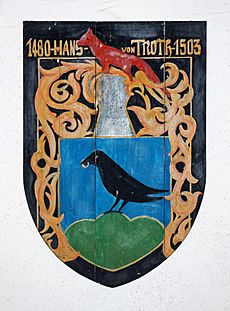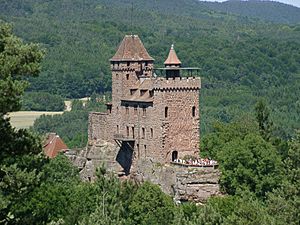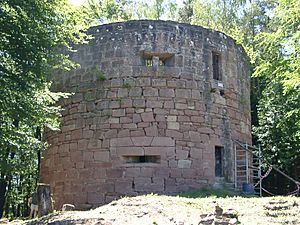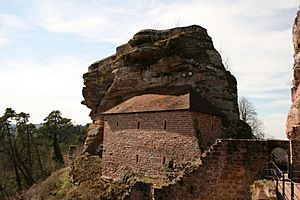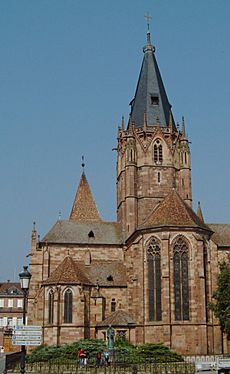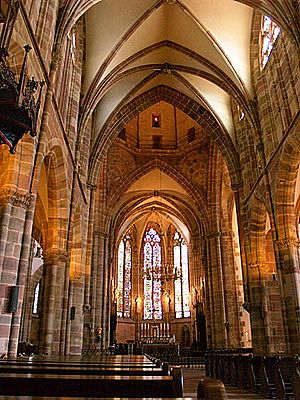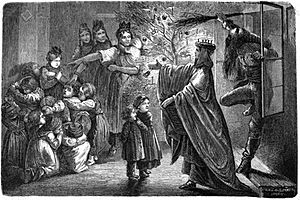Hans von Trotha facts for kids
Hans von Trotha, also known as Hans Trapp (born around 1450, died 1503), was a famous German knight. He was also a marshal for the Prince-Elector of the Palatinate, a powerful ruler. In 1480, the Elector gave him two castles, Berwartstein and Grafendahn. These castles were in the South Palatine part of the Wasgau region, inside the Palatinate Forest. In local stories, he is known as Hans Trapp or sometimes Hans Trott.
Contents
Family Life
Hans von Trotha came from the noble Trotha family. They were from an area now called Saalekreis. He was the fourth son of Thilo von Trotha, who was a marshal for the Archbishop of Magdeburg. Hans was likely born in Krosigk (today in Saxony-Anhalt) in the mid-1400s. His exact birth date is not known. His older brother, Thilo von Trotha, was born in 1443 and became a bishop.
Hans had only one son, Christoph. Christoph became the lord of Berwartstein Castle after his father. But Christoph had no sons. So, when he died in 1545, the family line ended. The castle then went to his son-in-law's family from Alsace.
Hans's Life and Deeds
Making Berwartstein Castle Stronger
As a younger son from a noble family, Hans started working for the Elector of the Palatinate. This was in the late 1470s. He proved himself to be very capable. By 1480, the Elector, Philip the Sincere, gave him two castles. These were Berwartstein and Grafendahn, which he could pass down to his family.
Within four years, Hans made Berwartstein Castle into a very strong fortress. It was almost impossible to attack back then. He built a special outpost called Little France in 1484. This was on a hill across from the castle. It had a powerful tower where large cannons could be placed. These cannons could fire from different directions, making it very hard for anyone to try and take Berwartstein.
However, Hans was not interested in Grafendahn Castle. It was about six kilometers away. It was probably already falling apart when he got it. By 1500, people said it was "uninhabitable." This was likely because Grafendahn had many owners over time. No one person took full responsibility for keeping it in good shape.
The Fight with Weissenburg Abbey
Hans became well known for his big fight with Henry, the abbot of Weissenburg Abbey. The abbot believed that Berwartstein Castle and its lands actually belonged to the monastery. He thought the Elector had not taken the castle fairly. The monastery had only wanted the Elector to protect it, not own it. In 1485, Hans demanded the lands that went with the castle. The abbot asked the Elector for help. But the Elector did not support the monastery. Instead, he made Hans a marshal and sold him all the disputed land.
When the fight got really bad, Hans did something extreme. He blocked the nearby Wieslauter river. This stopped the water supply to the town of Weissenburg, which was downstream. Hans built the dam near the village of Bobenthal. This was five kilometers south of Berwartstein. The river flows through a narrow area there. A small lake formed, flooding the fields near Bobenthal. After the abbot complained, Hans tore down the dam. This caused a huge flood in Weissenburg. The flood badly damaged the town's economy.
Facing Punishment
Hans von Trotha was now openly fighting against the abbot. Even the Emperor could not make him stop. So, in 1491, the abbot asked Pope Innocent VIII for help. Eight years later, Hans was called to the Pope's court by Pope Alexander VI. They wanted to question his loyalty to the Church. But Hans refused to go to Rome. Instead, he wrote a letter to the Pope. In his letter, he said he was a good Christian. But he also accused the Pope of bad behavior.
Because of this, the Church issued an "anathema" against Hans. This meant he was kicked out of the Church. To avoid the same punishment, his old friend, the Elector, publicly said he no longer supported Hans. In 1496, the German king, Maximilian I, also put an "imperial ban" on Hans. This meant Hans was an outlaw in the Holy Roman Empire.
However, the Elector only pretended to distance himself from Hans. Secretly, he sent Hans to the French king's court. This was during the Italian Wars. Hans was good at talking to people and solving problems. While he was there, the French king, Louis XII, gave him a special knighthood called Chevalier d’Or.
Death and Clearing His Name
Hans von Trotha lived through the punishments from the Emperor and the Pope. He died naturally on October 26, 1503, at Berwartstein Castle. Two years after his death, the punishments were officially lifted. The knight was buried in St. Anne's Chapel in Niederschlettenbach. This is four kilometers from Berwartstein. In 1967, the von Trotha family placed a memorial tablet in the chapel.
His Lasting Significance
The story of Hans von Trotha's fight with the abbey is shown in the great hall of Berwartstein Castle. This hall is now a restaurant, but people can still visit it.
Hans von Trotha was about 2 meters tall, which was very tall for his time. He became a local legend in the Palatinate region. People called him "Hans Trapp" or sometimes "Hans Trott." At first, some called him a "robber baron." But over time, he became a scary figure for children. He was known as the "Black Knight" (schwarzer Ritter). People said he was a restless spirit who roamed the Wasgau at night. His name was even linked to a scary figure in the Legend of the Jungfernsprung.
In nearby Alsace, around Saint Nicholas Day, Hans Trapp's name was used to scare children. He was the one who went with Saint Nicholas, not the usual figure of Knecht Ruprecht. An old Alemannic German poem from Alsace describes Hans Trapp's look: a white beard, a pointed hat, and a rod.
|
|
|


